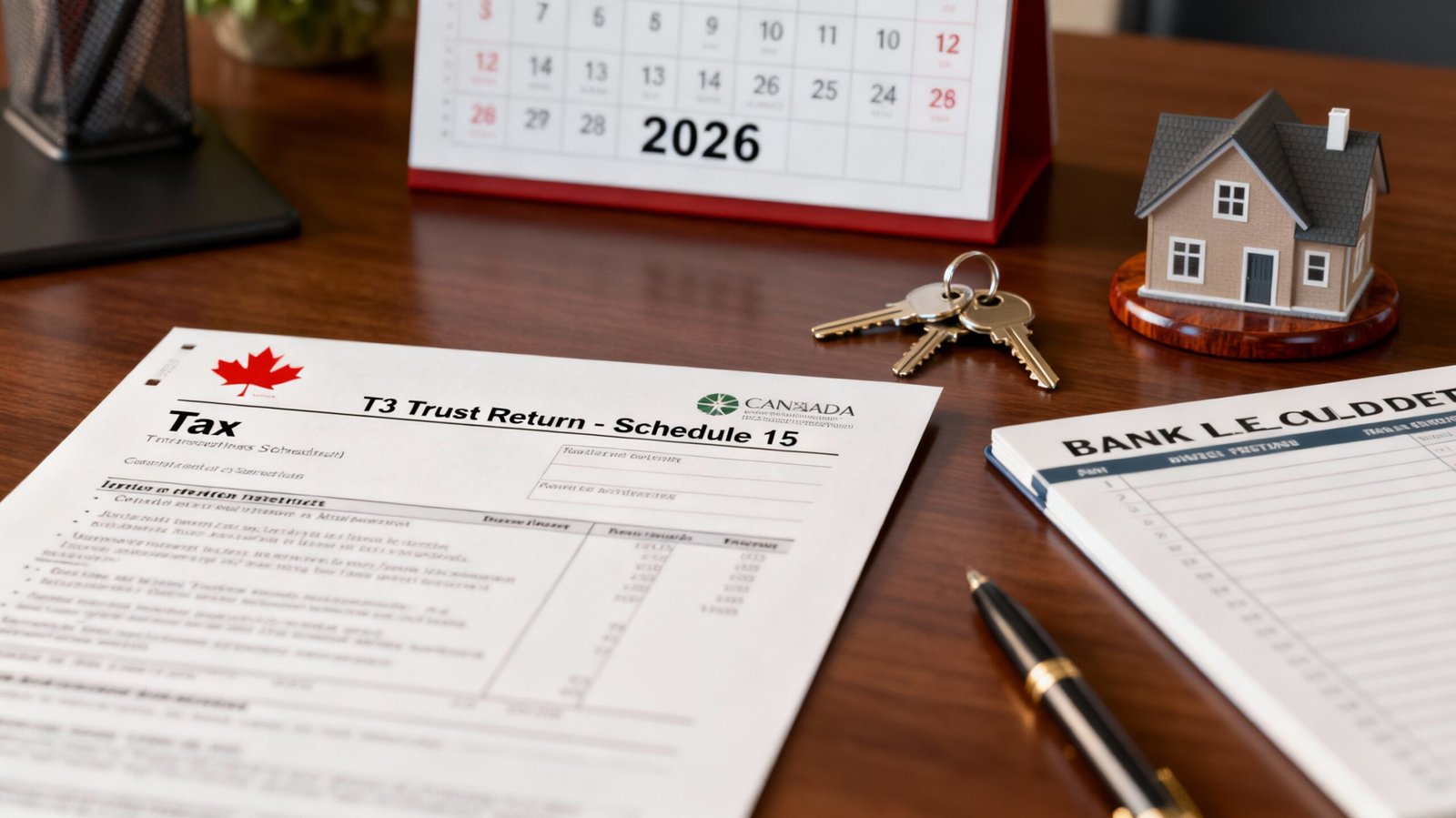Filing taxes for the first time in Canada starts the moment you arrive, as newcomers are considered tax residents from their very first day in the country. Importantly, you don’t need to wait until tax season to start receiving benefits – we can help you apply for credits like the GST/HST even before filing your first return.
Even if you have no income to report, we recommend filing a tax return. In fact, the Canada Revenue Agency (CRA) uses these returns to calculate your eligibility for various benefits and credits, including the Canada Child Benefit for families. With the tax filing deadline set for April 30th (June 15th for self-employed individuals), we’ve created this comprehensive guide to help you understand your tax obligations and maximize your benefits as a newcomer to Canada.
This step-by-step guide will walk you through everything you need to know about filing your first Canadian tax return, from determining your residency status to reporting worldwide income and claiming the benefits you’re entitled to receive.
Understanding the Canadian Tax System for Newcomers

The Canadian tax system might seem complex at first glance, but understanding its fundamentals will help you navigate your first filing experience with confidence. As a newcomer, familiarizing yourself with how taxation works in your new home is essential for financial success.
How taxes work in Canada
Canada operates on a self-assessment tax system where individuals calculate their own tax obligations and file annual returns. Unlike some countries, the Canadian tax system is based on your residency status rather than your immigration status. This means your tax obligations begin the moment you establish significant residential ties in Canada, which typically occurs on the date you arrive.
One fundamental aspect of Canadian taxation is that residents must report their “worldwide income” – meaning income from all sources both inside and outside Canada. This obligation applies for the part of the year that you were considered a Canadian resident.
A noteworthy aspect of Canadian taxation is that there’s no minimum income threshold required to file a tax return. Additionally, completing your return allows the Canada Revenue Agency (CRA) to determine your eligibility for various benefits and credits that could put money back in your pocket.
Canada employs a progressive taxation system, where the tax rate increases as your income rises. Your tax return contains essential information including your personal details, income, deductions, and tax credits.
Federal vs. provincial tax responsibilities
In Canada, income tax is collected at two distinct levels: federal (by the Canadian government) and provincial/territorial (by your province or territory of residence). The federal government sets the federal income tax rates, while each province and territory determines their own rates.
These two levels of taxation create a unique system where provincial or territorial income tax applies in addition to federal tax rates. Your total tax obligation combines both these rates, creating what’s sometimes called your “average tax rate”.
An important distinction is that the federal government collects both federal and provincial taxes in all provinces and territories except Quebec. This means most Canadians only need to file one tax return that calculates both obligations. However, Quebec operates its own tax collection system, requiring residents to file two separate returns – one with the federal government and another with the province.
The province or territory where you live on December 31 determines which provincial or territorial tax rates apply to you for that tax year. Therefore, if you’re planning to move between provinces, the timing could have tax implications.
While most provinces use a tax system where rates increase with income, Alberta stands as the only province with a flat 10% tax rate regardless of income level.
Key tax terms every newcomer should know
To effectively navigate the Canadian tax system, understanding these essential terms is crucial:
- Social Insurance Number (SIN): A nine-digit identifier required to file taxes and access government programs
- T4 slip: Document issued by employers showing your total remuneration and deductions for the year
- Notice of Assessment (NOA): Document received after filing that confirms your tax assessment, showing refund or amount owing
- Taxable income: Your income after various deductions, credits, and exemptions
- Tax credits: Reduce the amount of tax you owe, classified as refundable (paid regardless of income) or non-refundable (requiring income to claim)
- Tax deductions: Reduce the income amount you’re taxed on, potentially placing you in a lower tax bracket
- GST/HST credit: Quarterly payment helping individuals and families with low or modest incomes offset sales tax
- Canada Carbon Rebate: Quarterly payment helping eligible individuals offset federal pollution pricing costs
- Canada Child Benefit: Monthly payment helping families with children under 18
- Tax treaties: Agreements between countries designed to avoid double taxation
- Form T1135: Required for reporting foreign property worth over CAD $100,000
Understanding these fundamental components of the Canadian tax system provides the foundation you’ll need as we explore the specifics of determining your tax residency status in the next section.
Determining Your Tax Residency Status
“Your residency status in Canada may change from year to year. It can depend on the length and reason for your stay, if you leave temporarily or permanently, or if you live outside of Canada for part of the year.” — Canada Revenue Agency, Government of Canada, official tax authority
Your tax obligations in Canada start with understanding your residency status – a concept that’s fundamentally different from your immigration status. Since the Canadian tax system bases its requirements on where you establish your life rather than your citizenship, knowing your tax residency status is the crucial first step when filing taxes for the first time in Canada.
What makes you a tax resident in Canada
The Canada Revenue Agency (CRA) considers you a tax resident primarily based on your “residential ties” to Canada. These ties fall into two categories:
Significant residential ties include:
- Maintaining a home in Canada
- Having a spouse or common-law partner in Canada
- Having dependants in Canada
Secondary ties that further support your residency status include bank accounts, personal property, social memberships, driver’s licenses, and health insurance coverage in a Canadian province. Essentially, the CRA evaluates whether Canada is where you “regularly, normally, or customarily live”.
Many newcomers assume that citizenship or immigration status determines their tax obligations, when in reality, it’s these residential connections that matter most. Consequently, you could be a temporary worker but still be considered a tax resident if you’ve established significant ties.
Generally, if you’ve been legally admitted to Canada as a permanent or temporary resident (worker or student) and established significant residential ties, tax authorities will consider you a tax resident.
If you’re uncertain about your status, completing Form NR74 (Determination of Residency Status) can help the CRA provide an official determination.
How your arrival date affects your first tax return
The date you become a Canadian resident for tax purposes typically coincides with when you establish significant residential ties to Canada – often your arrival date. This date is critical since you’ll be required to report worldwide income from that specific day forward.
For example, if you arrived and established residency on June 1st, you must report all income earned both inside and outside Canada from June 1st to December 31st on your first tax return. Income earned before your arrival date would generally not be subject to Canadian taxation.
Furthermore, the CRA will assess whether you stayed in Canada for 183 days or more in the calendar year. If you did, you might be considered a “deemed resident” even without significant residential ties, which carries its own tax implications.
When calculating these 183 days, include each day or part-day you stayed in Canada, including days attending a Canadian university, working, or vacation days. Notably, if you lived in the US and commuted to work in Canada, you don’t need to include commuting days in this calculation.
Temporary vs. permanent residency tax implications
The distinction between temporary and permanent immigration status doesn’t directly determine your tax obligations. Instead, the strength and nature of your residential ties determine whether you’re a:
Factual resident: You maintain sufficient residential ties to Canada, even if temporarily absent. As a factual resident, you must report worldwide income for the part of the year you were resident and can claim all applicable deductions and credits.
Deemed resident: You don’t have significant residential ties but stayed in Canada for 183 days or more in the year. Deemed residents must report worldwide income for the entire year and pay federal tax plus a federal surtax instead of provincial/territorial tax.
Non-resident: You have not established significant residential ties and stayed less than 183 days in Canada. Non-residents generally pay tax only on Canadian-source income.
Important considerations for temporary residents include:
- If you’re in Canada temporarily for work, school, or vacation but maintain significant residential ties, you’re typically considered a factual resident.
- Permanent residency for immigration purposes doesn’t automatically make you a tax resident – it’s your actual ties to Canada that matter.
- If you maintain strong residential ties to both Canada and another country, tax treaties might determine which country has primary taxation rights.
All newcomers should know that you can start receiving benefit and credit payments upon arrival in Canada, even before filing your first tax return. Nevertheless, you’ll need to file returns annually to continue receiving these benefits, regardless of whether you have income.
Essential First Steps Before Filing Taxes

Image Source: Cansumer
Before diving into your first Canadian tax return, completing several practical preparations will significantly simplify your filing experience. These foundational steps not only establish your identity within the Canadian tax system but also streamline all future interactions with tax authorities.
Getting your Social Insurance Number (SIN)
The Social Insurance Number (SIN) serves as your tax identification number in Canada and acts as your gateway to the Canadian tax system. This unique nine-digit identifier is mandatory for filing taxes, receiving government benefits, and accessing various programs.
To apply for a SIN, you have three options:
- Online application through the Service Canada website
- In-person visit to a Service Canada Center
- Mail application (using form NAS2120)
The good news? There’s absolutely no fee to apply for your SIN.
When applying, you’ll need to provide specific documentation based on your status:
For permanent residents:
- Your Permanent Resident card or Confirmation of Permanent Residence
For temporary residents (workers/students):
- Valid work permit or study permit with authorization to work
Remember that if you’re a temporary resident, your SIN will begin with the number “9” and will have the same expiry date as your immigration document. Once you receive new immigration documents, you must update your SIN record to match the new expiry date.
Above all, protect your SIN information carefully. You must provide it whenever preparing tax information slips, but otherwise, treat it as confidential personal information. Failing to provide your SIN when legally required may result in a penalty of CAD 139.34.
Setting up your CRA My Account
The Canada Revenue Agency’s My Account serves as a secure portal that lets you view and manage your tax affairs online. Importantly, you cannot register for a CRA My Account until after filing your first tax return and receiving your Notice of Assessment (NOA).
Once you’ve filed your first return and received your NOA, your registration options include:
- Sign-in Partner method:
- Use your banking credentials from participating financial institutions
- Enter your SIN, date of birth, postal code, and an amount from your tax return
- Receive a CRA security code by mail within 10 business days
- CRA user ID and password method:
- Create a unique CRA user ID and password
- Set up security questions
- Receive a CRA security code by mail to complete registration
As a security measure, starting October 2021, multi-factor authentication became mandatory for accessing CRA My Account.
My Account provides valuable features such as:
- Viewing your tax return status and notices of assessment
- Downloading information slips
- Managing direct deposit details
- Changing your personal information
- Applying for benefits and credits
- Receiving CRA communications electronically
Organizing your pre-arrival financial information
Prior to filing your first Canadian tax return, taking inventory of your financial situation is crucial, particularly for assets you owned upon arrival in Canada.
On the day you arrived in Canada, document:
- The market value of all assets you owned
- Income earned before arriving in Canada
- Income from all sources after becoming a Canadian resident
This information is vital because:
- It establishes your entry value for foreign property (important for calculating future capital gains)
- It helps determine if you need to file additional forms for foreign property worth over CAD 100,000
- It affects the calculation of certain tax credits you may be eligible for
To begin receiving benefits even before filing your first return, complete form RC151 (GST/HST Credit Application for Individuals Who Become Residents of Canada). If you have children, also submit form RC66 (Canada Child Benefit Application) with schedule RC66SCH.
Keep in mind that while pre-arrival income isn’t taxable in Canada, you must still report it as the CRA uses this information to calculate certain tax credits. Organizing these documents early makes your first filing experience significantly smoother.
Gathering Required Documents for Your First Tax Return
Successful tax filing in Canada depends largely on having the right documentation ready before you begin. With proper preparation, you’ll avoid delays and ensure you maximize available credits and deductions for your first Canadian tax return.
Income slips and what they mean (T4, T5, etc.)
Income slips serve as official records of money you’ve earned or received throughout the tax year. These documents, issued by employers, financial institutions, and government agencies, form the foundation of your tax return.
You should receive most tax slips by the end of February, though some may arrive later. The most common slips include:
- T4: Shows employment income, including salary, wages, and payroll deductions. Box 14 displays your total employment income, while Boxes 16, 18, and 22 show your CPP contributions, EI premiums, and income tax deducted, respectively.
- T4A: Reports pension income, scholarships, RESP payments, or self-employment commissions. Students should watch for this slip as it documents scholarship and bursary income.
- T4E: Details Employment Insurance benefits you received during the tax year.
- T5: Reports investment income such as interest from bank accounts, dividends from Canadian corporations, or other investment distributions.
- T3: Documents income from trusts or mutual fund investments.
- T5008: Records securities transactions if you sold investments during the tax year.
Most of these slips can be accessed through your CRA My Account once it’s established. Many financial institutions likewise offer electronic versions through their online portals. Nevertheless, carefully compare any electronic versions against your last pay stub of the year to ensure accuracy.
Tracking foreign income documentation
As a newcomer, you must report all worldwide income earned after becoming a Canadian resident. This includes employment, self-employment, pensions, investments, and rental income from foreign sources.
To properly document foreign income:
- Convert all amounts to Canadian dollars using the exchange rate on the date you received the income. The Canada Revenue Agency accepts the Bank of Canada exchange rate or other widely available, verifiable sources.
- Keep copies of all foreign payment documents, especially if your home country’s tax year differs from Canada’s January-to-December calendar year.
- Gather documentation for any foreign tax already paid, as you may qualify for foreign tax credits to avoid double taxation. Form T2209 (Federal Foreign Tax Credits) may be required.
Moreover, if you own specified foreign property with a total cost exceeding CAD 139,336.02, you must file Form T1135 (Foreign Income Verification Statement). This includes foreign bank accounts, investments, real estate, and certain other assets.
For foreign-language documents, submit both the original and an acceptable English or French translation. Translations must be certified by an authorized professional such as a notary, translator in good standing with a provincial organization, or embassy official.
Receipts and records you need to keep
Beyond income slips, you should maintain organized records of other tax-relevant documents:
- RRSP contribution receipts: Usually available by March for contributions made in the first 60 days of the year, or immediately for other contributions.
- Medical expense receipts: Keep all receipts for medical services, prescriptions, and treatments.
- Tuition receipts: Form T2202 documents tuition fees and months of enrollment.
- Charitable donation receipts: Required for claiming tax credits for donations.
- Home office expenses: If applicable, gather related receipts and Form T2200 from your employer.
Undoubtedly, maintaining original copies of all tax documents is crucial, as the CRA generally requires original documentation. Store these records for at least six years after filing, as the CRA may request verification during this period.
Even when filing electronically, you don’t need to submit receipts with your return. Nonetheless, keep them accessible in case of a CRA review. Your notice of assessment, which you’ll receive after filing, should be retained permanently as it contains important carry-forward amounts for future returns.
Step-by-Step Guide to Filing Your First Tax Return
With all your documents organized, it’s time to tackle the actual process of filing your taxes in Canada. The filing method you choose can significantly impact both the complexity and the speed of receiving your refund.
Choosing between paper filing and electronic filing
Canada offers two primary methods for submitting your tax return: paper filing and electronic filing. Each has distinct advantages depending on your situation.
Paper filing involves completing a physical T1 General Income Tax and Benefit Return form. As a first-time filer, this method gives you the option to mail your return to the Canada Revenue Agency (CRA). The primary drawback? Processing times can stretch up to 8 weeks for paper returns filed on time.
Conversely, electronic filing through the NETFILE service allows you to submit your return directly to the CRA using certified tax software. This method typically processes within 2 weeks and could deliver your refund in as few as 8 business days. Additionally, for the 2024 tax year, you’ll need an Access code when using NETFILE, which the CRA provides after entering your name, date of birth, and SIN.
Interestingly, 9 out of 10 tax returns in Canada are now filed online, demonstrating most Canadians’ comfort with electronic filing.
Using tax software for first-time filers
For newcomers to Canada, tax software simplifies the filing process tremendously. The CRA certifies various tax software programs each year for electronic filing through NETFILE.
When selecting software, consider these factors:
- Cost: Many options offer completely free services, while others follow a “pay-what-you-want” model
- Complexity handling: Ensure the software can manage your specific situation (rental income, self-employment, etc.)
- User-friendliness: Look for programs with guided wizards rather than requiring you to select specific tax forms
Popular NETFILE-certified options include TurboTax, Wealthsimple Tax, and UFile, among others. TurboTax and Wealthsimple offer free trials without obligation so you can test which interface works best for you.
Most tax software automatically explores tax-saving opportunities and offers features like auto-fill, which retrieves your tax slips directly from the CRA.
When to consider professional tax help
Although self-filing is increasingly accessible, certain situations warrant professional assistance:
Primarily, if you have a modest income and simple tax situation, the Community Volunteer Income Tax Program (CVITP) offers free tax clinics across Canada. These clinics operate year-round but are especially available between March and April.
These free clinics come in various formats:
- Walk-in clinics (first-come, first-served)
- Drop-off services where you leave documents and return later
- Appointment-based options (both in-person and virtual)
For more complex situations—such as self-employment, investment income, or significant life changes—a professional tax service might be worthwhile. Tax professionals stay current with tax laws and can identify deductions you might miss, potentially offsetting their fee.
Remember that your first tax return establishes the foundation for all future filings, making accuracy particularly important as you begin your financial life in Canada.
Understanding Tax Credits and Benefits for Newcomers
“The Canada Revenue Agency (CRA) offers financial support through various benefits, credits, and programs.” — Canada Revenue Agency, Government of Canada, official tax authority
Beyond just fulfilling legal obligations, filing taxes in Canada opens the door to valuable benefits specifically designed to support newcomers financially. As a first-time filer, understanding what you’re eligible for can significantly impact your household budget.
GST/HST credit and Canada Carbon Rebate
The GST/HST credit offers quarterly tax-free payments to offset sales taxes for individuals with low or modest incomes. As a newcomer, you don’t need to wait until your first tax return to apply—simply complete Form RC151 (GST/HST Credit Application for Individuals Who Become Residents of Canada).
Correspondingly, the Canada Carbon Rebate (formerly the Climate Action Incentive payment) helps eligible individuals offset federal pollution pricing costs. This quarterly payment is available to residents of Alberta, Manitoba, New Brunswick, Newfoundland and Labrador, Nova Scotia, Ontario, Prince Edward Island, and Saskatchewan. Those living in rural areas receive 20% more than urban residents to account for higher energy usage and fewer public transportation options.
Canada Child Benefit for newcomer families
The Canada Child Benefit (CCB) provides tax-free monthly payments to families with children under 18. For the 2024-2025 period, eligible families can receive up to $863.53 monthly per child under 6, and $728.60 for each child aged 6-17. Indeed, these payments can add between 18-20% to the annual income of a family earning $50,860.43.
To apply as a newcomer with children, submit Form RC66 (Canada Child Benefits Application) along with Form RC66SCH (Status in Canada and Income Information). Primarily, permanent residents must provide proof of birth for any children you’re applying for.
Provincial and territorial benefits you may qualify for
Most notably, applying for the CCB automatically registers you for various provincial and territorial benefits. These include:
- Alberta child and family benefit
- BC family benefit
- New Brunswick child tax benefit
- Newfoundland and Labrador child benefit
- Northwest Territories child benefit
- Nova Scotia child benefit
- Nunavut child benefit
- Ontario child benefit
- Prince Edward Island child benefit
- Yukon child benefit
By filing your tax return annually, you maintain eligibility for these benefits that can substantially ease your financial transition to life in Canada.
Reporting Foreign Income and Assets Correctly
Moving to Canada doesn’t mean leaving behind your financial ties to your home country. As a newcomer, understanding how to report foreign income and assets is crucial for tax compliance and avoiding penalties.
What foreign income must be declared
First and foremost, Canadian residents must report all worldwide income on their tax returns, regardless of where it’s earned. This includes:
- Employment income from foreign employers
- Investment income from abroad
- Rental income from properties outside Canada
- Foreign pension payments
- Self-employment income earned internationally
When reporting foreign income, you’ll need to convert amounts to Canadian dollars. The CRA accepts the Bank of Canada exchange rate or other widely available, verifiable sources that are used consistently year to year. For income received throughout the year, you can use the annual average exchange rate.
Remember that even if your foreign income is below the CAD 139,336.02 reporting threshold for the T1135 form, you must still include it on your tax return. The reporting threshold only affects whether you need to file the additional form, not whether the income is taxable in Canada.
Form T1135 for foreign property over $100,000
The Foreign Income Verification Statement (Form T1135) is required if you own specified foreign property with a total cost exceeding CAD 139,336.02 at any time during the tax year. This includes:
- Foreign bank accounts
- Shares in non-resident corporations
- Real estate outside Canada (except personal-use property)
- Funds held outside Canada
- Debts owed by non-residents
- Interests in foreign trusts
The form has two reporting methods: Part A (simplified) for property valued between CAD 139,336.02 and CAD 348,340.05, and Part B (detailed) for property worth CAD 348,340.05 or more.
Failing to file T1135 on time carries significant penalties—CAD 34.83 per day (minimum CAD 139.34) up to a maximum of CAD 3,483.40. Meanwhile, the CRA can also extend the reassessment period by three additional years for unreported foreign income.
Avoiding double taxation through tax treaties
To prevent taxation of the same income in multiple countries, Canada has established tax treaties with nearly 100 nations. These agreements determine which country has primary taxation rights when your financial situation crosses borders.
Given that you’ve likely paid tax in your home country on some income, you can claim a federal foreign tax credit using Form T2209. This credit reduces your Canadian tax by accounting for taxes already paid elsewhere, though it cannot exceed your Canadian tax payable on that foreign income.
Most importantly, tax treaties contain tie-breaker rules that help determine your tax residency when you have significant ties to multiple countries. Despite this complexity, the basic rules for foreign tax credits remain largely consistent regardless of which country you’re earning income from.
For documents in languages other than English or French, submit both the original and a certified translation to ensure proper processing.
What Happens After You File Your First Tax Return
After submitting your first tax return, you enter the waiting phase. Understanding what happens next helps ensure you manage your finances effectively as a newcomer to Canada.
Understanding your Notice of Assessment
Once the Canada Revenue Agency (CRA) processes your tax return, you’ll receive a Notice of Assessment (NOA) – an official evaluation document that confirms your submission has been processed. This crucial document contains several important sections:
Account summary – Shows the result of your assessed tax return, which could be a refund, zero balance, or amount owing. This includes any outstanding balances from previous returns.
Tax assessment summary – Outlines the main lines on your assessed return and amounts used to calculate your balance.
Explanation of changes – Details any adjustments the CRA made to your return based on information you provided or what they have on file.
Your NOA may also include program-specific information like Home Buyers’ Plan statements or Lifelong Learning Plan details if applicable.
Receiving your tax refund
The timeline for receiving your refund depends on your filing method:
- Electronic submissions: typically within 2 weeks
- Paper returns: up to 8 weeks
- Non-resident returns: up to 16 weeks
If you signed up for direct deposit, your refund will automatically arrive in your bank account. Without direct deposit, you’ll receive a check through mail.
Occasionally, your payment may not appear on your notice if you made it around the same time you filed. In this case, payments take up to 10 business days to reflect in the CRA system. To confirm payment status, log into My Account or call the Individual Tax Account Balance Automated Service.
Making corrections if you made mistakes
Don’t panic if you discover an error on your return! Simply wait until you receive your NOA from the CRA and then request changes. You have several options for corrections:
- My Account: Use the “Change my Return” feature online (fastest option, processed in about two weeks)
- ReFILE: If you filed electronically, use this service through the same tax software
- Mail: Submit form T1-ADJ or a letter to your tax center (takes approximately eight weeks)
For complex adjustments, processing may take up to 20 weeks. After your adjustment is processed, you’ll receive a Notice of Reassessment showing any changes to your return.
Remember that keeping your Notice of Assessment is important as it contains information you’ll need for future tax returns and establishes your eligibility for CRA’s My Account.
Conclusion
Filing taxes as a newcomer to Canada might seem complex, but breaking it down into manageable steps makes the process much clearer. Starting with your residency status determination, gathering required documents, and understanding available benefits creates a solid foundation for your financial life in Canada.
Remember that proper tax filing opens doors to valuable benefits like the GST/HST credit, Canada Carbon Rebate, and Canada Child Benefit. These programs can significantly support your household budget while you establish yourself in your new home country.
Many newcomers find professional guidance helpful for their first tax filing. BOMCAS Canada is your source for getting your tax returns filed correctly the first time in Canada. Their expertise helps ensure you maximize available credits and avoid common pitfalls that could delay your benefits.
After submitting your return, watch for your Notice of Assessment and keep it safe – this document proves crucial for future filings and accessing CRA’s online services. Should you discover any mistakes, take advantage of the adjustment options available through CRA My Account or paper submissions.
Canadian tax authorities understand that newcomers face unique challenges. Take time to learn the system, ask questions when needed, and maintain thorough records. Success with your first tax return builds confidence for all future filings and helps secure your financial future in Canada.
FAQs
Q1. When should I file my first tax return as a newcomer to Canada? You should file your first Canadian tax return in the year following your arrival. For example, if you became a resident for tax purposes in 2024, you would file your first return by April 30, 2025.
Q2. What documents do I need to file my first Canadian tax return? You’ll need your Social Insurance Number (SIN), income slips (like T4s), receipts for deductions and credits, and documentation of any foreign income. Also gather records of your assets’ value on the day you arrived in Canada.
Q3. Can I receive benefits before filing my first tax return in Canada? Yes, you can start receiving certain benefits upon arrival, even before filing your first return. Complete Form RC151 for the GST/HST credit and Form RC66 for the Canada Child Benefit if you have children.
Q4. How do I report foreign income on my Canadian tax return? You must report all worldwide income earned after becoming a Canadian resident. Convert amounts to Canadian dollars using the appropriate exchange rate. If you own foreign property worth over CAD 100,000, you’ll need to file an additional Form T1135.
Q5. What happens after I file my first Canadian tax return? After filing, you’ll receive a Notice of Assessment (NOA) from the Canada Revenue Agency. This document confirms your tax assessment and may show a refund, balance owing, or zero balance. Keep this NOA as it contains important information for future filings.










 View Our Location
View Our Location





 181 Meadowview Bay, Sherwood Park, AB T8H 1P7, Canada (Online Clients Only)
181 Meadowview Bay, Sherwood Park, AB T8H 1P7, Canada (Online Clients Only)